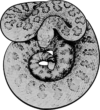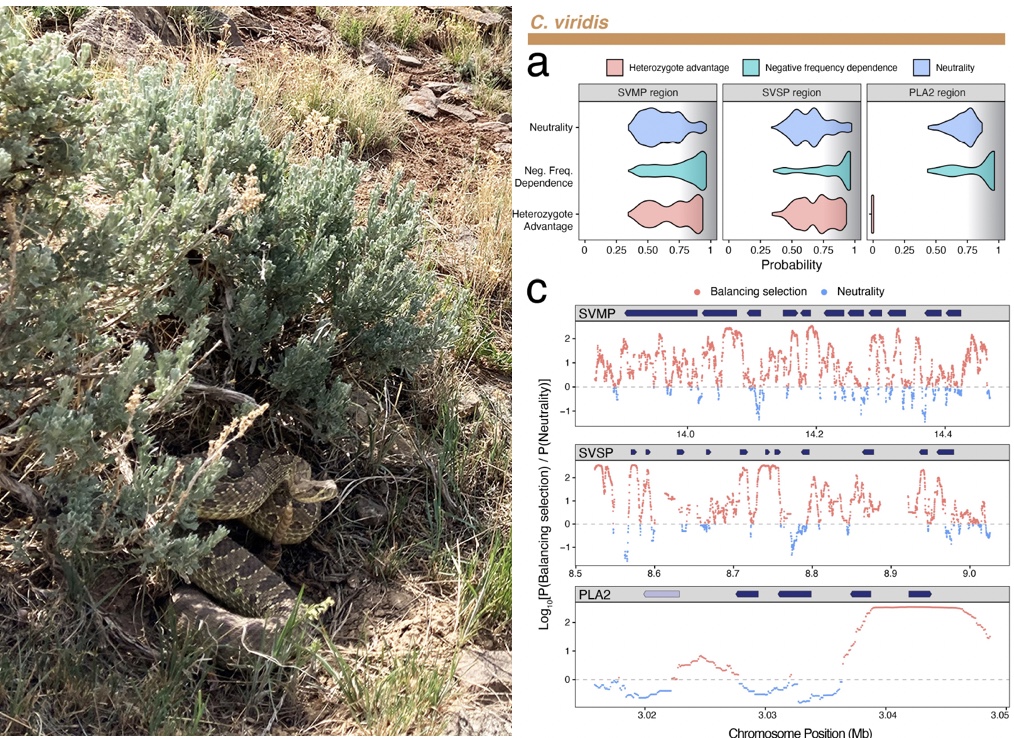Congrats to lab alum Drew Schield and other current and former students (Sid Gopalan, Blair Perry, Rich Adams) on a new paper that suggests that balancing selection, likely driven by predator-prey dynamics, gives rise to extensive variation in snake venom within and between populations of venomous snakes.
Schield, D.R., B.W. Perry, R.H. Adams, M.L. Holding, Z. L. Nikolakis, S.S. Gopalan, C.F. Smith, J.M. Parker, M. DeGiorgio, S.P. Mackessy, and T.A. Castoe. 2022. The roles of balancing selection and recombination in the evolution of rattlesnake venom. Nature Ecology & Evolution. PDF
Below is a press release we put together with Greg Pederson from UTA on this paper that explains why this is particularly interesting:
New genomic research explains how predator-prey relationships drive extreme variation in snake venom – Study led by Castoe lab describes evolution mechanism used by snakes in genetic arms race.
New research by a team including biologists at The University of Texas at Arlington provides fresh insight on how rattlesnakes evolve to maintain an advantage in the ongoing “arms race” between snake venom and prey resistance. The team published its findings in a paper titled “The roles of balancing selection and recombination in the evolution of rattlesnake venom,” which appears in the July 18 edition of the journal Nature Ecology and Evolution.
“Our findings help explain decades of seemingly contradictory theory and evidence for what drives the extreme variation observed in snake venoms,” said Todd Castoe, UTA professor of biology and a co-author of the study. “It turns out that the arms race between snakes and prey ends up favoring the constant re-shuffling of venom variants that are favored, leading to the retention of lots of venom variants over time, some of which are ancient.”
Lead author of the paper is Drew Schield, a postdoctoral fellow in Ecology and Evolutionary Biology at the University of Colorado at Boulder who received his Ph.D. in Quantitative Biology from UTA in 2018.
“We sequenced the genomes of rattlesnakes across the western United States to investigate genetic diversity in parts of the genome that encode venom components that enable the snakes to kill prey,” Schield said. “Ultimately, our focus was to test how deep or shallow the ‘gene pools’ of major venom components might be.”
Snake venom is comprised of a toxic mix of proteins and enzymes and is delivered through a bite which kills or immobilizes prey. Over time prey may evolve mechanisms to resist snake venom, and snakes in turn may evolve new venom components to kill prey more effectively. The team’s findings overturn decades of thought on what factors shape venom gene evolution and venom variation, Castoe said.
Researchers have long presumed that snake venom evolves in a directional fashion, with natural selection favoring a single “best” form of venom for killing prey.
“The issue with this hypothesis is that we know prey evolve the ability to resist venom, imposing reverse selection pressure back onto snake predators to evolve more diverse venom repertoires to circumvent prey resistance,” Schield said. “The ecological context of these predator-prey dynamics seemed to us to be quite inconsistent with strong directional evolution of venom, since this would eventually leave snakes without sufficient genetic diversity to keep pace with prey resistance.”
The researchers hypothesized that balancing selection, rather than directional selection, may be a better way to explain the ongoing arms race between snake predators and their prey. Balancing selection maintains genetic diversity and allows multiple functional versions of a gene to persist over time.
“In the case of snake predators, this could lead to a more expansive venom toolkit, with a more diverse set of tools to subdue prey,” Schield said.
“This study is exciting because it proposes a mechanism, for the first time, that could enable this predator-prey arms race, and shows that this special kind of selection — balancing selection, that maintains many ‘versions’ of a gene for lots of different venom proteins — is the key for how snakes stay ahead of prey resistance to venom,” Castoe said.
Co-authors of the new study include Blair Perry, a postdoctoral researcher in the School of Biological Sciences at Washington State University; Richard Adams, assistant professor of biological and environmental sciences at Georgia College; Zachary Nikolakis and Siddharth Gopalan, doctoral students in Castoe’s lab; and Jesse Meik, assistant professor of biological sciences at Tarleton State University. Perry, Adams, and Meik all received their doctoral degrees from UTA.
Previous work done by Castoe and members of his lab to map the rattlesnake genome proved invaluable in the new study. Over a three-year period, team members collected 68 specimens of two species of Western rattlesnake — the prairie rattlesnake and the Northern Pacific rattlesnake — from Colorado, Idaho, Montana, and California in order to test venom composition and analyze whole-genome data.
“The problem is that testing these alternative forms of natural selection really requires an investigation of populations of venomous snakes, which to date has been limited and has lacked a full genomic context,” Schield said. “That’s where we come in. We developed some of the first whole-genome data for rattlesnake populations and interpreted their genetic variation in the context of the chromosome-level prairie rattlesnake genome assembly we developed a few years ago.”
This dataset was used to test population genetic predictions of forms of selection, with the team finding overwhelming evidence in support of balancing selection operating on venom genes, which allowed for the maintenance of genetic diversity in venom gene regions and led to a more diverse venom toolkit.
One area where understanding the diversity of venomous snake genomes can be particularly beneficial is in anti-venom therapeutics, where such knowledge could help scientists create new antibodies and save lives around the world, Schield said.
“Our findings are significant because they call into question the idea that snake venom evolution is dominated by directional selection for a single optimal form and strongly argue that testing alternative scenarios is important when we consider how snakes adapt to prey,” Schield said.
Castoe noted that the most significant challenge to treating snakebite globally is the extreme variation in snake venom between snake populations and among species.
“Our work provides the first genomic evidence that helps explain how complex patterns of natural selection, driven by the arms race between snakes and their prey, lead to this extreme variation in venom composition observed in snakes,” Castoe said. “Accordingly, it paves the way for understanding the factors that create and maintain this venom variation, which hopefully leads to a better understanding of how to treat snakebite worldwide.”
.

